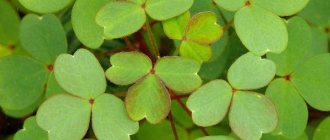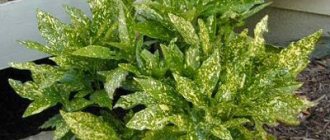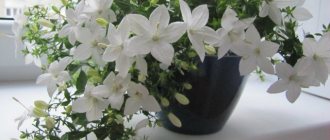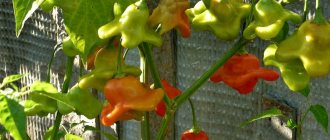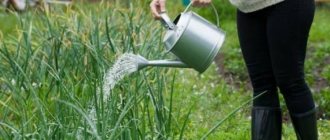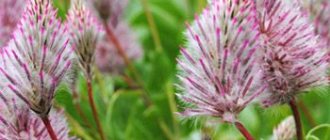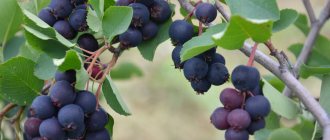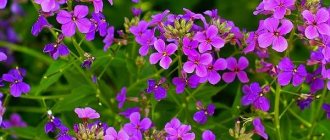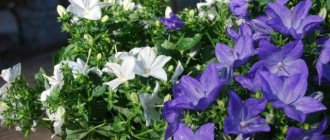Platycodon flower is a perennial herbaceous plant. Most often found in forest clearings, edges of rocky slopes in the Far East, Eastern Siberia, Korea, China and Japan. Platycodon was brought to Europe at the end of the 18th century, and became widespread even later - in the middle of the 19th century. Half a century later, the assortment of nurseries included several forms of Platycodon grandiflora.
Platycodon can be confused with a large bell. This is what people call it - wide bell. From Greek, the name of the flower is translated as “wide bowl,” which very aptly describes it. In nature, the plant blooms only with blue flowers.
It has a large fleshy rhizome, thin, straight, densely leafy stems from 20 to 80 cm high, on which there are ovate or elongated narrow leaves with finely toothed edges. The lower leaves form a basal rosette. Stems and leaves have a bluish tint. The flowers are solitary or collected in panicles of three to five pieces, large, wide open, up to eight centimeters in diameter.
When does Platycodon bloom?
There are forms with dark purple and white flowers. The unusually swollen flower buds resemble lanterns. It blooms for two months, starting in mid-July. The fruit is an ovoid capsule with flat, glossy oval seeds.
Platycodons are not aggressive and grow in one place for a long time without degenerating; they go well with most garden flowers: phlox, daylilies, peonies, Siberian irises, asters, sedums, cereals, geraniums, wormwood.
Dwarf varieties are an excellent decoration for rocky gardens, compositions with miniature varieties of coniferous and deciduous trees. The wide bell will delight you with its presence on the windowsill.
Description
The perennial grows in Korea on rocky soils, Eastern Siberia in glades, in the Land of the Rising Sun and China. The flowers are in the form of large, large bells, hence the name. It became famous in the mid-19th century, but gained popularity at the beginning of the 20th century.
It can reach a height of up to 1.2 m; the rhizome is a large bulb with root shoots. The leaves are light green, elongated towards the ends, and may have denticles along the edges. Bell flowers are large, up to 8 cm, can be single or up to 5 pieces on a stem, colors range from blue to white. On the bell flower itself, veins (thin lines) of a darker color are clearly visible.
Flowering begins in July and lasts 2 months. During this time, an egg-shaped box is formed, where the seeds are located.
How to plant Platycodon seeds in the ground
Platycodon seeds photo
- Platycodon seeds are sown in open ground in warm spring (late April) or before winter (late October).
- Cover the top with a layer of compost or sifted soil with a layer of two to three centimeters.
- This method of planting gives results by the end of May. The first shoots may appear in late May, and more likely in early June.
Sowing Platycodon with Platycodon seeds in open ground photo
- The flower slowly forms and blooms after one to two years.
- The seedlings need to be thinned out several times, ultimately leaving 20 cm between the bushes.
Broadbell platycodon grandiflora
Thanks to its roots, the plant easily adapts to different soil conditions. Tall shoots can reach a height of 100 cm. Neat leaves below form a rosette, and up to 5 large flowers can appear in inflorescences. The petals are quite thick, so the flowering period is long - about 2 months.
Platycodon wakes up in the spring about two weeks later than other perennial plants. On average, Platycodon blooms from June to August with large flowers, the size of which can reach 8 cm. The stems and buds of Platycodon are poisonous, but they coexist well with other plants. Next to the broadbells you can plant phloxes, peonies, geraniums, wormwood, irises, and be careful with dipladenia
The plant is a bush with foliage. The leaves of most Platycodon are oblong, with a smooth edge, but there are plants with small jagged edges. The main decoration of the plant is flowers.
Most varieties bloom in mid-June. Flowers in the axils at the tops bloom, showing inflorescences of 2-5 buds. The peduncle is quite flexible, so under the influence of gravity the buds bend down. Most often, the corolla consists of five petals, but in some varieties they are arranged in many tiers. These are double and semi-double types of broadbells. When flowering, up to ten shoots can appear on one adult plant.
Platycodons bloom only for 2-3 years, when the rhizome has gained sufficient mass. But in late autumn the plants acquire brightly colored leaves. Its lemon and then yellow-red leaves last until frost, decorating the garden. After flowering is complete, the seeds ripen in the seed capsules. They fully ripen in September-October.
Platycodon from seeds at home: growing and caring for seedlings
When to plant Platycodon seeds for seedlings?
Platycodon is sowed for seedlings at the end of February or beginning of March:
- For sowing, soil for flowering plants consisting of peat soil, humus, and sand is suitable.
- the ground must be thoroughly loosened, the seeds carefully placed on top at a distance of 2-3 cm, sprinkled with a thin layer of sand;
- moisten the soil with seeds from a spray bottle with water at room temperature;
- cover with film, place in a warm place with a temperature of 20-22 ºC;
- crops should be placed on a windowsill with bright, diffused light, preferably a western or eastern window;
- the next watering of crops is carried out only after the top layer of soil has dried;
- The first shoots appear after a week or two.
When asked whether there is a need to plant Platycodon seeds in the soil, there are two views from gardeners: some believe that planting is not necessary, others recommend planting the seeds, but not deeply, only three to five millimeters. It is better to cover not with soil, but with a thin layer of sand.
Subsequent care of seedlings includes:
Platycodon seedlings ready for planting photo
- after germination, remove the film from the crops;
- lower the temperature to 18-20 ºC;
- water as needed;
- after watering, carefully loosen the soil;
- if the seedlings have three or four leaves, dive into separate pots with a diameter of about 10 cm;
- grow until planted in open ground at the end of May.
Before planting, seedlings need to be acclimated to the street: take them out onto the porch or balcony so that the plants get used to the wind and sun.
Growing at home
For growing in a pot, compact varieties of wide bellflower are chosen as a houseplant. Tall hybrids are best left for decorating flower beds and mixborders.
The unpretentiousness of the plant even at home pleasantly surprises the owners. The only requirement of the flower is coolness. There is no place for platycodon on a windowsill heated by heating devices. Otherwise, caring for indoor flowers is no different from garden specimens.
There is always a place for wide bells in landscape design or garden decoration: as a separate accent, a spectacular background for other flowers, in mixed plantings of the same variety but of different colors. The best neighbors for the culture are any bells, adenophora, and phlox. High varieties go well with irises and peonies. Roses can be shaded with delicate inflorescences of dwarf hybrids planted in the lower tier of the flower bed.
Flowers with long stems are great for cutting and making bouquets. To do this, you should wait until all the buds open. Platycodon is an unpretentious and very grateful flower; it can bloom for decades without causing much trouble to the gardener.
How to properly plant Platycodon flowers in open ground
Platycodon flowers planting and care photo in open ground
Soil preparation
When the threat of frost has passed, in May-June, platycodons are planted in open ground. The soil should be loose, rich, drained, and not very wet. Good soil for the plant contains a small amount of sand. The soil on the site needs to be loosened and added: 1 tbsp. a spoonful of complex fertilizers and 0.5 cups of wood ash.
How to plant
Before planting, seedlings must be watered abundantly; the plant should be replanted very carefully and carefully so as not to damage the roots. Use a small garden trowel to move the sprouts with the clod of soil. Small holes are made under the seedling at a distance of 15-20 cm from each other. The sprout is placed in the hole, sprinkled with additional soil and lightly compacted. After which the ground is watered and mulched with peat.
Important: Platycodon is a perennial plant and does not like transplants. A place in the flowerbed is allocated, taking into account that he will live there for approximately 10 years.
Flowering period and care during this period
Platycodon is a perennial plant that pleases the eye with bright and large flowers that bloom at the top of the bush either singly or in groups. The bud is slightly inclined downwards due to the short and flexible peduncle.
In appearance it is similar to a bell, because all the petals are connected in one place. Among the variety of varieties, semi-double species are popular, the petals of which are arranged in several tiers. During flowering, caring for the plant is easy.
Incredibly beautiful perennial flowering
Conditions for growing Platycodon and proper care
Watering, mulching and illumination of the area
After planting, it is necessary to provide systematic but meager watering of the plant for two weeks, periodic feeding or mulching. Do not allow the roots to flood and water to stagnate in the soil. After planting, shade the flower from direct sunlight. Carry out mulching in the spring, feeding the soil with organic matter. Then the amount of water is reduced, and moistening is carried out no more than once every three days. The soil is loosened and weeds are removed. Broadbells will be comfortable in areas with weak partial shade or generous sunlight. Platykodon needs to be shaded from the scorching rays.
Feeding
The plant will be very grateful for feeding. The fertilization regime is determined by the soil in which it grows. The soil is extremely nutritious; then in the first year of cultivation, only mulch the soil with organic fertilizers. Also add complete mineral mixtures at the budding stage. From the second year, two types of fertilizing are applied:
- mulching with organic matter (peat, compost, humus) in early spring or early autumn;
- fertilizing with complete mineral fertilizers in May, June and July at monthly intervals.
This strategy allows you to achieve long and abundant flowering of the broadbell, which pleases the eye for two months. After flowering, starting in September, the color of the foliage changes very interestingly - from lemon to yellow with crimson. Beauty can last until the first frost.
Limiting growth and pruning
Platycodons grow upwards in approximately the third year. To avoid damage in the wind, it is necessary to pinch or spray from time to time in the spring with special agents - inhibitors that inhibit growth.
The rest of the care is not complicated:
- Remove fading flowers to prevent seed formation and stop flowering. The procedure stimulates a greater number of new buds;
- if the bushes are too tall and powerful, the broad bell begins to lie down, tie the flowers to a support;
- in the fall, after drying begins, do not wait for the bushes to die; cut the stems as low as possible.
Platycodon pruning
The platycodon plant, if not pruned, will eventually lose its attractive shape. To avoid this, the bush is pinched and treated with a special agent that slows down growth.
Worth knowing! Bush pruning is carried out twice a year - in spring and autumn. If the bush is very elongated in growth, it is tied to some kind of support.
Formation of a perennial
Reproduction of platycodon by cuttings and dividing the bush
Vegetative methods of propagation of Platycodon are often unsuccessful, but they ensure the preservation of the variety of the original plant.
How to take cuttings
You can try to propagate the plant by cuttings, however, it is not often possible to bring the process to a successful result.
- Shoots with heels can be separated in the spring at the beginning of vigorous growth and rooted in a moist substrate, after first keeping them in a root solution for 24 hours.
- After about a month, a root system will form.
How to divide a bush
If Platycodon grows on sandy soil, you can try to propagate it by dividing the bush. The plant is carefully dug up and examined. Using a sterile, sharp instrument, the shoots with buds are separated, the sections are sprinkled with ash or sulfur, and the divisions are planted.
6.Reproduction
There are several ways to propagate Platycodon, but the most common is to grow bluebells from seeds. Cuttings are carried out by cutting off the stems, but the percentage of successfully rooted plants is extremely low.
6.1.Growing from seeds
In flower shops you can find a wide variety of Platycodon varieties. This flower is easy to grow from seeds and does not require much effort in caring for young plants. In the first year after sowing, plants usually form only a basal leaf rosette, and the first buds become a decoration of this bush only in the second year.
↑ Up,
6.2.How to collect seeds
You can use personally collected seeds to propagate Platycodon, but it is worth remembering that varietal plants do not always retain their attractive appearance with this method of propagation. Often daughter bushes bloom less abundantly and for a longer period of time, and the flowers may differ in shade from the parent bushes.
Only seeds that have fully ripened on the plants are suitable for collection - unripe planting material simply will not sprout. In the summer months, the very first ones - large and bright flowers are marked with colored threads - it is from these buds that the highest quality planting material is obtained.
↑ Up,
To prevent the seeds from spilling onto the surface of the ground as they ripen, the green seed pods are wrapped in a bandage. To collect seeds, it is better to use a fine - dry and warm day in the first half of September.
After ripening, the boxes are separated from the plants and the seeds are removed, which are then laid out on a sheet of paper and dried in a well-ventilated area for 2 - 3 days.
Planting material prepared in this way is collected in paper envelopes and stored in a cool and dry place, used as needed for 1 - 2 years.
↑ Up,
6.2.1.Sowing seeds
Platycodon is often grown as seedlings at home, and then the plants are transferred to the garden in May. Seeds are sown in late winter - early spring.
In order to increase the germination of planting material, the seeds are placed in a saucer, covered with gauze. Fill the saucer with warm water with growth preparations dissolved in it - epin or zircon. In this form, the seeds are kept for 2 days.
Preliminary cool stratification increases germination well. For this period, the seeds are sprinkled with a small amount of barely damp river sand, placed in a plastic bag and sent to the refrigerator for a month.
↑ Up,
To sow seedlings, you should choose special boxes - greenhouses and make drainage holes in their base. A drainage layer in the form of expanded clay or small pieces of foam is placed on the bottom.
The boxes are filled with soil based on peat and river sand, the surface of which is thoroughly moistened using a sprayer. Seeds are laid out on the surface of the soil and lightly pressed into the ground or sprinkled with a very thin layer of river sand 2-3 mm thick. Repeated spraying is carried out and the seedling boxes are covered with a transparent lid or covered with plastic film to create a greenhouse effect.
Leave the seedlings in a warm room at normal room temperature in a well-lit place without direct sun access. The shelter is lifted daily and any water condensation that appears is wiped off. Ventilation time is increased daily.
You can sow the seeds directly into separate cups, placing 2 - 3 seeds in each cup. As sprouts appear, excess, weaker plants are simply cut off with scissors. With this method, diving will not be necessary. If you sow in special peat containers, then the plants are planted directly in pots in the garden.
↑ Up,
6.2.2.Picking, caring for seedlings
1 - 2 weeks after sowing, it will be possible to observe the appearance of the first shoots. With the appearance of the first shoots, the shelter is completely removed and the seedlings are hardened, lowering the air temperature to 16 - 18 degrees Celsius. The soil is kept evenly moist, but not waterlogged.
When each bush can boast 2 - real leaves. carry out a dive. When diving, each sprout is carefully lifted, along with a lump of earth, and transferred to a small separate glass. When diving, they try to minimally injure the long root.
1 - 2 weeks after picking, nitrogen fertilizers are applied for the first time in a very weak concentration.
↑ Up,
6.3.Dividing the bush
Due to the peculiarities of the root system, plant division is very difficult and often as a result of such manipulations the bushes die. Before deciding to divide mature plants into several parts, you should think twice.
Mature bushes 4 to 5 years old are dug out of the ground, trying not to damage the long and fragile roots, and shake off any remaining soil. If lateral shoots with buds are noticeable at the base of the plant, they can be separated with a knife.
After separation, the wound surface must be sprinkled with coal powder or treated with wood ash for drying and disinfection.
The cuttings are planted in the garden and the soil around the plants is kept evenly moist for 2 - 3 weeks. 1 - 2 years after division, young plants can form the first buds, but often both bushes die.
↑ Up,
6.4.Cuttings
Cuttings are carried out using young shoots that appeared in the spring. They are separated from the mother bush with a sharply sharpened garden knife at the end of spring or very beginning of summer.
Each cutting should contain 2 - 3 internodes and a heel at the base. The lower leaves are completely removed from the cuttings, and the upper ones are shortened by a third or even half their length to reduce moisture loss. The bases of the cuttings are dipped in rooting powder.
Prepare small flower pots filled with a mixture of peat and river sand in equal parts. The surface of the soil is moistened with warm water and the cuttings are immersed in it to a depth of about 1 cm. The cuttings should be positioned at a slight angle.
↑ Up,
The plants are covered with a lid on top to maintain high air humidity. Rooting is carried out in a warm and well-lit place without direct sun.
The signal for the successful completion of the rooting process will be the young shoots that appear at the base of the cutting. A month after the first signs of growth appear, such bushes are ready for planting in the garden.
You can root the cuttings in a simple glass of water, in which an activated carbon tablet has previously been placed. The water is changed every 3 - 4 days, and plants whose roots have reached 1 - 2 cm in length are planted in the ground.
↑ Up,
Pests and diseases
Platycodon in garden design photo
Immunity to disease is the main advantage of Platycodon. During periods of prolonged dampness, it may develop gray rot. It is necessary to loosen the soil so that the plant does not suffer from waterlogging. If these measures are not enough, remove very affected plants, treat the rest with a fungicide - a two percent solution of Fundazol, copper sulfate or a one percent solution of Topsin-M. Repeat the treatment after ten days.
The most dangerous pests are rodents - mice, moles, from which the root system can suffer. There are many ways to get rid of them.
Caring for the broadbell
Wild varieties of Platycodon are not spoiled by weather conditions; their cultivated varieties are also resilient and unpretentious. But proper care significantly increases the decorative value of the bushes, prolongs flowering and makes it abundant.
Plants tolerate drought well and react negatively to excess watering. However, to prolong flowering during hot periods without rain, it is recommended to irrigate the plantings additionally. From the beginning of budding until the last flowers, it is worth keeping the substrate slightly moist. Watering is carried out moderately and only when the top layer of soil dries.
The poorness of the soils where the broad bell plant grows does not mean that fertilizing is contraindicated for it. If the soil in the garden is nutritious and fertilizers were applied during planting, then the first fertilizing will be needed when the buds appear. When the soil is poor, plants are fertilized in two ways:
- mulching the surface around the bushes with compost, peat or humus (in spring and autumn);
- watering with the addition of mineral fertilizers once a month, three times during the summer.
The rest of the care consists of timely removal of faded buds, timely staking of stems when lodging and preparing plants for cold weather.
Preparing for winter
Even small plant seedlings are able to survive the harsh winter in central Russia. To do this, they will need minimal help from a gardener:
- Before the onset of cold weather, without waiting for the death of the above-ground part of the bush, it is completely cut off as close to the soil as possible.
- If the winter is expected to be snowless, the flowerbed is mulched with any plant debris: hay, dry leaves, pine needles, peat.
- Stop all watering in advance, and in rainy weather cover the area with platycodons from excess moisture.
- The root can withstand severe frosts, but in a humid environment it rots and dies.
Bellflower sprouts appear late in the spring; the bush has enormous growth power and manages to grow and bloom on time. There is no need to worry about the safety of the roots when Platycodon has not emerged from the ground along with its neighbors in the flowerbed.
Diseases and pests
Immunity to diseases and resistance to pests is one of the main advantages of broad bells. The only disease that threatens flowers in the garden is gray rot. The defeat occurs from long-term waterlogging and can be stopped at the very beginning by stopping watering and loosening the soil in the flowerbed.
If it was not possible to eradicate the rot, spray with special fungicides (Topsin, Fundazol or copper sulfate), having previously removed all diseased plants from the area. After 10 days, the treatment is repeated.
Rodents - mice and moles - can damage beneficial roots; each gardener has his own ways of dealing with them. But insects avoid plants and Platycodon has no specific pests.
Platycodon at home
Platycodon at home planting and care photo series Astra
Planting and care at home is almost no different from street flowers. Platycodon looks just as wonderful indoors as it does in outdoor flower beds. The main thing is to select a cooler place with diffused lighting and a pot with good drainage. The broad bell will continue to bloom for a long time. Replant only as needed in winter, when the plant is dormant.
Important: if you grow a plant in pots, you should pay attention to dwarf varieties, for example the Astra series with flowers of various shades. Their height does not exceed 20-25 cm. They are compact, miniature, but the size of the buds practically does not change.
Watering and loosening the soil
Oakleaf hydrangea - winter-hardy varieties, planting and care
Platycodon is a perennial flower that is unpretentious in cultivation, but in order for the bush to please with its flowering for a long time, it is necessary to water it in a timely manner. In general, it tolerates dry summers well. But occasionally the bells are irrigated. It is especially important to monitor soil moisture during the period when buds appear. In other cases, watering is carried out only after it has been noticed that the top layer of soil is completely dry.
When planting a bell, the soil should be loose and have drainage. To do this, prepare a mixture: humus, compost, peat and foliage. All ingredients are mixed in equal quantities. By mulching, soil acidity is regulated.
Platycodon varieties with photos and names
Platycodon cultivation and care in open ground in the photo Sentimental Blue variety 'Sentimental Blue'
The broadbell is represented by one species - Platycodon grandiflorus, or large-flowered broadbell.
There is one species, but many varieties. The most famous:
Platycodon Astra White Platycodon grandiflorus Astra White photo
Album - a stem 60 to 80 cm high, with large white flowers up to eight centimeters in diameter, blooms from late June to August;
Platycodon Astra Pink Platycodon grandiflorus Astra Pink photo
Shell Pink - bush up to 80 cm high, large pale pink flowers;
Marisil Blue is a compact bush up to 35 cm high, blue flowers with a beautiful lavender hue;
Platycodon 'Astra Semi-Double Blue' photo
Fairy Snow - a bush up to 80 cm high with the most delicate single white or slightly lilac flowers, with thin blue veins;
Epoema is a bush of only 20 cm with violet-blue flowers;
Snowflakes - up to half a meter high, variety with white semi-double flowers;
Maser of Pearl - soft pink flowers on bushes up to 60 cm high.
Important: when growing different varieties in the same garden, you should take into account the fact that the plants are cross-pollinated. It will not be possible to preserve varietal properties: the seeds are obtained as hybrids. To preserve the varietal characteristics of plants, one variety of Platycodon should be grown on the site.
Features of Platycodon
Platycodon's rhizome is fleshy, and the height of its straight, thin, densely leafy shoots can vary from 0.2 to 0.8 m. Opposite leaf plates have an elongated, narrow or ovoid shape, as well as a finely toothed edge. The leaves located at the bottom are part of the basal rosette. The leaf blades and shoots have a light bluish tint. Flowers can be single or 3-5 pieces collected in paniculate inflorescences. The wide-open flowers are quite large, they can reach 8 centimeters in diameter; on the surface of the blue petals, a network consisting of thin dark-colored veins is clearly visible. There are forms whose flower color can be white or dark purple. Externally, the swollen buds of such a plant are very similar to lanterns. Flowering lasts about 8 weeks and begins in the second half of July. The fruit is an ovoid capsule containing glossy, flat, ovoid seeds. It is recommended to grow such a flower in the garden together with a tall bell, gypsophila or low-growing phlox.
GARDEN BELLS. PLATICODON. Website sadovymir.ru
Useful properties of platycodon
The roots of the broadbell are similar to the roots of ginseng, they contain biologically active substances saponins, inulin, protein, calcium, iron, phosphorus and other mineral elements, as well as vitamins B1 and B2. They have long been used in folk Korean and Chinese medicine as hemolytic, anti-inflammatory, expectorant, and promote sputum production.
Koreans grow Platycodon for its edible roots, which are slightly bitter and have a peculiar smell. Collected from spring to autumn. Two to four year old roots are considered valuable. Used in preparing meat skewers, soups, stews from noodles, meat, and vegetables.
Landing
In order for the plant to bloom for a long time, it will need to be provided with sufficient light. Platycodon does not like dark places. With slight shading, it stretches out, but well-prepared seedlings will be able to take root in secluded places in the garden. Platycodon can be sown in spring and autumn, but spring planting is more often used.
The soil
When planting, you must choose soil with good drainage properties. The bushes will grow and bloom well only in the absence of stagnant water. If water accumulates at the planting site, then you need to use drainage. The delicate root system of Platycodon does not tolerate repeated transplants, so care must be taken to ensure that the plant can bloom quietly for 5-10 years.
Light loams rich in nutrients are best suited for Platycodon. When digging, you can add a little ash and fertilizer to the ground.
Seed preparation
It is best to grow Platycodon from seeds, which can be directly placed in the soil or grown as seedlings first. Before planting, the seeds are soaked for a couple of days in a gauze bag. The time of emergence of seedlings depends on the characteristics of planting and care and ranges from 10 to 21 days.
Seedling
The seeds should be sown in a container with prepared soil mixture at the end of February. To prepare it, sand, humus and peat are mixed in equal parts. The seeds are planted to a depth of half a centimeter, after which the soil is moistened. Before the sprouts appear, the container is covered with film and kept in a warm room for about a week with daily watering.
Popular: Planting perennial lychnis for landscape design
When green seedlings appear, the boxes are moved to the light and the film is removed. The appearance of several leaves indicates that the seedlings are ready for picking, and until the final transplantation into the ground, the plants will be in small pots with a diameter of 10 cm.
Landing
When replanting, it is more convenient to work with damp soil, so the soil should be moistened first. The distance between the holes should be about 30 cm, and their size should allow the entire root system to be transplanted from a seedling pot along with a lump of soil. You need to act as carefully as possible, and this will reduce the stress of the plant from replanting. Do not shake off the soil or straighten the roots, as this leads to damage to the root system.
The first time after transplanting, the plants need to be shaded a little. To quickly adapt, replanting should be done on cloudy days, as this will help avoid too much sunlight. At first, watering should be scanty but frequent. Do not allow water to get on the wide bells themselves.
Planting a plant
Most often, Platycodon is planted with seeds. They can be planted either in open ground or in a separate bed or pots for seedlings. When planted in open ground, Platycodon will bloom only next year. The soil at the planting site should be fertile and well loosened. Seeds can be sown after the end of frost or in late autumn.
Seeds for seedlings are sown in January. To begin with, they are placed in gauze for two days and immersed in water. This will increase germination. Afterwards, the seeds are sown in a seedling container and sprinkled with a thin (up to 0.5 cm) layer of earth, watered with warm water and covered with film. After the first leaves appear, it is better to remove the film. It is recommended to keep seedlings at temperatures from 20 °C to 27 °C.
Platycodon loves well-loosened soil.
Transplantation into open ground can be done in mid-spring.
Advice. To reduce the likelihood of stress in young flowers, you can completely submerge them in water at room temperature for a few minutes before planting.
Possible problems
Platycodons are disease resistant. The greatest danger for them is excessive watering, which causes rot. When affected areas are detected, simple measures are often sufficient: reducing watering, loosening the soil. Damaged parts of the plant are removed during transplantation. An emergency measure may be a transplant. If rot continues to spread despite the measures taken, then it is necessary to use fungicides for disinfection.
It is not for nothing that flowers are used in oriental cooking. Their taste attracts various rodents. To expel mice and moles from the area, you can use various rattles and fill the holes with water. If platycodon requires replanting, it is best to do it in winter, when the plant is dormant.
Platycodon is easily pollinated. Therefore, if you independently prepare seeds for further planting, you must carefully place other plants nearby to avoid losing the characteristics of the variety in the future.
Where can you use a bell?
In landscape design, plants can be used for various purposes. They allow you to make bright accent spots in clearings and lawns, in flower beds. Bluebells are often used as partners for roses and other plants. Flowers look great in compositions that involve continuous flowering. Plants can not only be used in combination with other types of flowers, but also used alone. Platycodon are also used in bouquets.
Toraj-namul
The prepared root, from which the bitterness has been removed, is cut into strips. To it add a little finely chopped green onion, garlic and half a spoon of ginger, sesame oil. The mixture is fried in a frying pan, 100 ml of water is added and simmered until completely evaporated. After this, add a little more sesame oil and salt, and the salad is ready.
Currently reading:
- How to grow Chinese cabbage in open ground
- Planting to decorate the site with three types of coniferous trees
- Choosing cucumbers for open ground according to your preferences
- Exquisite juncus (rumen) spiral-shaped in the interior
Share the news on social networks
About the author: Lyudmila Vasilievna Nosikova
Agronomist of the state agricultural enterprise "Garovskoe" of the Khabarovsk region of the Khabarovsk Territory.
Platycodon: varieties and varieties
If you translate the name of this flower from Greek, you get “wide bowl”.
Compared to the usual bell, platycodon has larger flowers, open and reminiscent of a five-pointed star. It is most often found in purple, blue and white colors. The double forms of this flower also have an inner circle of petals. Thus, the flower looks like two bells: one inside the other. The most common varieties of Platycodon include:
- White "Album". One of the most common varieties. The stems reach 80 cm. Large white flowers are 8 cm in diameter. Sometimes you can see blue veins on the flowers.
Album variety
- Shell Pink. A very beautiful decorative variety. The height and size of the inflorescences does not differ from white ones.
Variety Shell Pink
- Blue "Mariesii blue". A very expressive and fairly common variety. Its characteristic feature is blue inflorescences.
Variety Mariesii blue
- Large-flowered "Fairy Snow". This variety is considered the most sophisticated. Its white or lilac flowers with blue veins will delight you for two months of summer.
Fairy Snow variety
- "Apoyama". This low-growing variety is very similar to field bells, only its leaves and flowers are much larger.
Variety Apoyama
- "Snow flakes" is a semi-double variety. Its main difference is fluffy white flowers.
Variety Snow flakes
Fertilizer and feeding of Platycodon
Platycodon usually does not require additional fertilizer if planted in fertile soil. If the quality of the soil is in doubt, you can apply fertilizer before planting. To do this, when digging, you need to add half a glass of wood ash and 1 tbsp. l. complex mineral fertilizer for every square meter of bed.
Mulch the plant bed
During the summer it will be enough to apply mineral fertilizers twice. And then only if your bed is not mulched with organic matter, for example, peat or humus.
Diseases and pests
Platycodon has very good immunity to diseases and pests. Only occasionally can a plant suffer from gray rot. This disease usually develops due to overwatering. Gray or yellowish-brown spots appear on the leaves. In this case it is necessary:
- Remove all damaged Platycodon leaves and throw them away from the area or burn them.
- Loosen the soil thoroughly and do not water it in the near future.
- Treat the plant with a fungicide - you can use Bordeaux mixture and other preparations (Fundazol, Skor, Ordan, Maxim).
Important! If almost the entire platycodon bush is affected by gray rot, it is better to dig it up and burn it to prevent infection of neighboring plants.
As for pests, they are practically not found on the surface of Platycodon leaves and stems. Insects can parasitize the roots of the bellflower. It is difficult to determine this, so it is better to try to regularly loosen the soil and replant the bushes in a new place after 5-7 years.
Care
Resistant and unpretentious platycodons survive the Central Russian cold well. They calmly survive winters in the Moscow region and Leningrad regions, but freeze out in the absence of snow. To prevent the death of bushes when there is no snow, they must be mulched for the winter after pruning. Dry leaves and other available materials are excellent as mulch. You should not remove dead leaves and stems in the fall; it is better to do this in the spring when removing the cover.
Plants benefit from moderate watering, which can be increased during bud formation and flowering. It is important to remember that Platycodon tolerates drought better than flooding, so if there is heavy rainfall, watering can be temporarily suspended.
Regular fertilizing is beneficial for plant growth and beautiful flowering, but is not necessary. When using natural organic mulch (compost, humus or others), you can refrain from using fertilizers. If necessary, mineral fertilizers are applied from May to July once a month.
Popular: Exotic varieties of calistegia from the Bindweed family
To stimulate the formation of new buds, faded flowers must be removed. To prevent the plant from stretching upward too much, you can pinch it a little. If the plant has become overly elongated and lost its stability, tying it up will support it.
Often, in the 3-4th year of life, the plant grows taller than indicated in the description. To stop growth, you can treat the flowers with an inhibitor in the spring. This will slightly slow down the growth of bushes that have just begun to develop. To stop growth, the drug "Athlet", which is widely available in garden centers, has proven itself to be excellent.
Broadbells can grow in an apartment like ordinary indoor plants. They look great in pots, and caring for them is practically no different from caring for outdoor flowers. In order for flowers to please all year round, it is necessary to place the pots in a cool place and ensure good drainage. Watering indoor platycodon should be a little more often in the hot season, and in winter it is better to reduce it. For comfortable growth, the flower will need a lot of diffused light.

